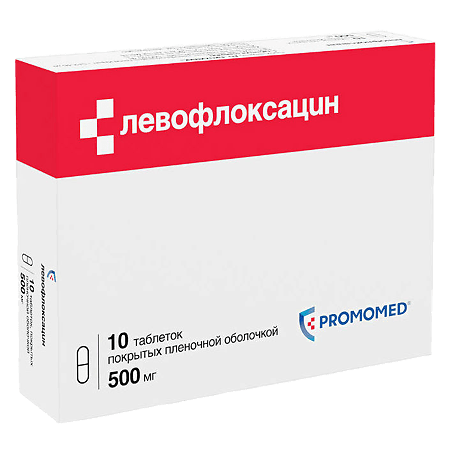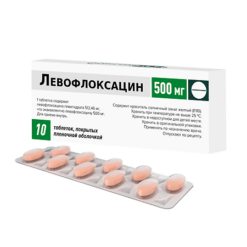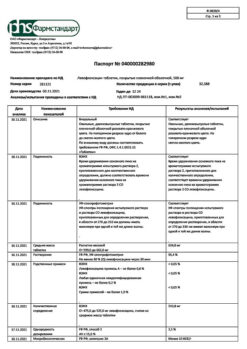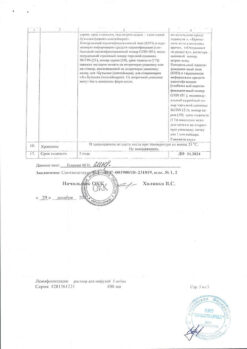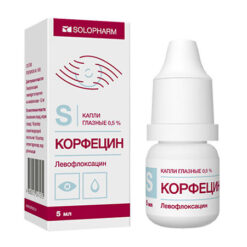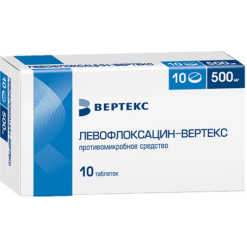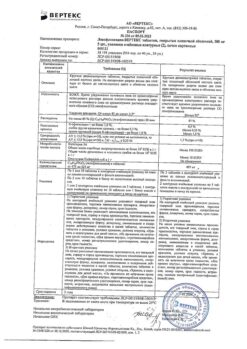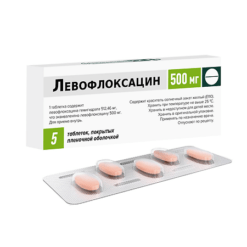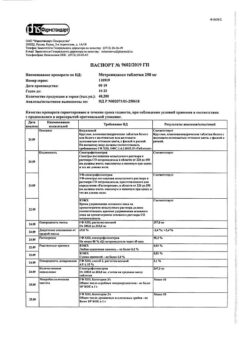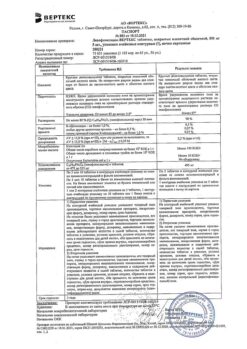No products in the cart.
Levofloxacin, 500 mg 10 pcs
€1.00
Out of stock
(E-mail when Stock is available)
Description
Pharmacodynamics
A synthetic broad-spectrum antibacterial drug from the group of fluoroquinolones containing levofloxacin, the left-handed isomer ofloxacin, as the active substance.
Levofloxacin blocks DNA-giase and topoisomerase IV, disrupts superspiralization and cross-linking of DNA breaks, inhibits DNA synthesis and causes deep morphological changes in cytoplasm, cell wall and membranes of microbial cells.
Levofloxacin is active against most strains of microorganisms both in vitro and in vivo.
In vitro
Sensitive microorganisms (MPC <2 mg/L; zone of inhibition >17 mm)
– Aerobic Gram-positive microorganisms: Bacillus anthracis, Corynebacterium diphtheriae, Corynebacterium jeikeium, Enterococcus faecalis, Enterococcus spp., Listeria monocytogenes, Staphylococcus coagulase-negative methi-S(I) [coagulase-negative methicillin-sensitive/ moderately sensitive], Staphylococcus aureus methi-S (methicillin-sensitive), Staphylococcus epidermidis methi-S (methicillin-sensitive), Staphylococcus spp. CNS (coagulazonegative), Streptococci group C and G, Streptococcus agalactiae, Streptococcus pneumoniae peni I/S/R (penicillin-moderately sensitive/sensitive/resistant), Streptococcus pyogenes, Viridans streptococci peni-S/R (penicillin-sensitive/resistant).
– Aerobic Gram-negative microorganisms: Acinetobacter baumannii, Acinetobacter spp., Actinobacillus actinomycetemcomitans, Citrobacter freundii, Eikenella corrodens, Enterobacter aerogenes, Enterobacter cloacae, Enterobacter spp, Escherichia coli, Gardnerella vaginalis, Haemophilus ducreyi, Haemophilus influenzae ampi-S/R (ampicillin-sensitive/resistant), Haemophilus parainfluenzae, Helicobacter pylori, Klebsiella oxytoca, Klebsiella pneumoniae, Klebsiella spp, Moraxella catarrhalis β+/β- (producing and non-producing beta-lactamases), Morganella morganii, Neisseria gonorrhoeae pop PPNG/PPNG (non-producing and producing penicillinase), Neisseria meningitidis, Pasteurella canis, Pasteurella dagmatis, Pasteurella multocida, Pasteurella spp, Proteus mirabilis, Proteus vulgaris, Providencia rettgeri, Providencia stuartii, Providencia spp., Pseudomonas aeruginosa (hospital infections caused by Pseudomonas aeruginosa may require combined treatment), Pseudomonas spp., Salmonella spp., Serratia marcescens, Serratia spp.
– Anaerobic microorganisms: Bacteroides Jragilis, Bifidobacterium spp., Clostridium perfringens, Eusobacterium spp., Peptostreptococcus, Propionibacterium spp., Veillonella spp.
– Other microorganisms: Bartonella spp., Chlamydia pneumoniae, Chlamydia psittaci, Chlamydia trachomatis, Legionella pneumophila, Legionella spp, Mycobacterium spp., Mycobacterium leprae, Mycobacterium tuberculosis, Mycoplasma hominis, Mycoplasma pneumoniae, Rickettsia spp., Ureaplasma urealyticum.
Moderately sensitive microorganisms (MPC = 4 mg/l; inhibition zone 16-14 mm)
– Aerobic Gram-positive microorganisms: Corynebacterium urealyticum. Corynebacterium xerosis, Enterococcus faecium, Staphylococcus epidermic/is methi-R (methicillin-resistant), Staphylococcus haemolyticus methi-R (methicillin-resistant).
– Aerobic Gram-negative microorganisms: Campylobacter jejuni/coli.
– Anaerobic microorganisms: Prevotella spp., Porphyromonas spp.
Levofloxacin-resistant microorganisms (MPC > 8 mg/L; zone of inhibition ≤13 mm)
– Aerobic Gram-positive microorganisms: Staphylococcus aureus methi-R (methicillin-resistant), Staphylococcus coagulase-negative methi-R (coagulase-negative methicillin-resistant).
– Aerobic Gram-negative microorganisms: Alcaligenes xylosoxidans.
– Anaerobic microorganisms: Bacteroides thetaiotaomicron.
– Other microorganisms: Mycobacterium avium.
Clinical efficacy
In clinical studies, the drug has been effective in the treatment of infections caused by the following microorganisms. Aerobic gram-positive microorganisms: Enterococcus faecalis, Staphylococcus aureus, Streptococcus pneumoniae, Streptococcus pyogenes.
Aerobic Gram-negative microorganisms: Citrobacter freundii, Enterobacter cloacae, Escherichia coli, Haemophilus influenzae, Haemophilus parainfluenzae, Klebsiella pneumoniae, Moraxella (Branhamella) catarrhalis, Morganella morganii, Proteus mirabilis, Pseudomonas aeruginosa, Serratia marcescens.
Others: Chlamydia pneumoniae, Legionella pneumophila, Mycoplasma pneumoniae.
Resistance
Resistance to levofloxacin develops as a result of a stepwise process of mutations in the genes encoding both type II topoisomerases: DNA-Gyrase and topoisomerase IV. Other mechanisms of resistance, such as the mechanism of influence on the penetration barriers of the microbial cell (a mechanism characteristic of Pseudomonas aeruginosa) and the mechanism of efflux (active elimination of the antimicrobial agent from the microbial cell), can also decrease the sensitivity of microorganisms to levofloxacin.
In view of the specific mechanism of action of levofloxacin there is usually no cross-resistance between levofloxacin and other antimicrobial agents.
Pharmacokinetics
Absorption
Levofloxacin is quickly and almost completely absorbed after oral administration. Simultaneous intake of food has little effect on absorption of levofloxacin. Absolute bioavailability when administered orally is 99-100%. After a single use of 500 mg of levofloxacin maximum concentration in plasma (Cmax) is achieved within 1-2 hours and is 5.2±1.2 µg/ml. Pharmacokinetics of levofloxacin is linear in the dose range from 50 to 1000 mg. Equilibrium concentration of levofloxacin in plasma when administered with 500 mg of the drug 1 or 2 times per day is reached within 48 hours.
On day 10 of oral administration of 500 mg once daily, the Cmax of levofloxacin was 5.7±1.4 µg/mL, and the minimum plasma concentration of levofloxacin (concentration before the next dose) (Cmin) was 0.5±0.2 µg/mL.
On day 10 of oral administration of Levofloxacin 500 mg twice daily, the Cmax
was 7.8±1.1 µg/mL, and the Cmin was 3.0±0.9 µg/mL.
Distribution
The binding to serum proteins is 30-40%. After a single and repeated intake of 500 mg of the drug the volume of distribution of levofloxacin averaged 100 l which indicates good penetration of levofloxacin into human organs and tissues.
Infiltration into the bronchial mucosa, epithelial lining fluid, alveolar macrophages
. After a single oral administration of 500 mg of the drug, maximum concentrations of levofloxacin in bronchial mucosa and epithelial lining fluid were reached within 1 h or 4 h and were 8.3 µg/g and 10.8 µg/mL, respectively, with penetration rates in bronchial mucosa and epithelial lining fluid compared to plasma concentrations of 1.1-1.8 and 0.8-3, respectively.
After 5 days of oral administration of 500 mg of the drug, mean concentrations of levofloxacin 4 hours after the last drug administration in the epithelial lining fluid were 9.94 µg/mL and in alveolar macrophages were 97.9 µg/mL.
Pulmonary tissue penetration
The maximum pulmonary tissue concentrations after oral administration of 500 mg of levofloxacin were approximately 11.3 µg/g and were reached 4-6 h after drug administration with penetration ratios of 2-5 compared to plasma concentrations.
Alveolar fluid penetration
After 3 days of administration of 500 mg of the drug once or twice daily, maximum concentrations of levofloxacin in alveolar fluid were reached 2-4 h after drug administration and were 4.0 and 6.7 µg/ml, respectively, with a penetration factor of 1 compared to concentrations in plasma. Bone penetration
Levofloxacin penetrates well into cortical and cancellous bone tissue in both proximal and distal femur with a penetration coefficient (bone tissue/plasma) of 0.1-3. Maximum concentrations of levofloxacin in the cancellous bone tissue of the proximal femur after oral administration of 500 mg of the drug were approximately 15.1 µg/g (2 hours after drug administration).
Cerebrospinal fluid penetration
Levofloxacin poorly penetrates into the cerebrospinal fluid.
Permeability to prostate tissue
After oral administration of 500 mg of the drug once daily for 3 days the mean concentration of levofloxacin in prostate tissue was 8.7 mcg/g and the mean prostate/plasma concentration ratio was 1.84.
Urinary concentrations
The mean urinary concentrations 8-12 h after oral doses of 150 mg, 300 mg, and 600 mg of levofloxacin were 44 µg/ml, 91 µg/ml, and 162 µg/ml, respectively.
Metabolism
Levofloxacin is metabolized to a small extent (5% of the dose taken). Its metabolites are desmethyllevofloxacin and levofloxacin N-oxide, which are excreted by the kidneys. Levofloxacin is stereochemically stable and does not undergo chiral transformations. Excretion
Levofloxacin is relatively slowly excreted from the blood plasma after oral administration (half-life (T1/2) is 6-8 hours). Excretion is mainly through the kidneys (more than 85% of the dose taken). Total clearance of levofloxacin after a single dose of 500 mg was 175±29.2 ml/minute.
There are no significant differences in the pharmacokinetics of levofloxacin when administered intravenously and when administered orally, confirming that oral and intravenous administration are interchangeable.
Pharmacokinetics in selected patient groups
The pharmacokinetics of levofloxacin do not differ in men and women. Pharmacokinetics in elderly patients do not differ from those in younger patients, except for differences in pharmacokinetics associated with differences in creatinine clearance (CK).
In renal failure, the pharmacokinetics of levofloxacin are altered. As renal function deteriorates, renal excretion and renal clearance decrease and T1/2 increases.
Pharmacokinetics in renal failure after a single oral dose of 500 mg of levofloxacin.
Indications
Indications
Treatment of infectious and inflammatory diseases caused by microorganisms sensitive to levofloxacin:
– community-acquired pneumonia;
– complicated urinary tract infections and pyelonephritis;
– chronic bacterial prostatitis;
– skin and soft tissue infections;
– for the complex treatment of drug-resistant forms of tuberculosis;
– prevention and treatment of anthrax in the airborne route of infection.
Levofloxacin can be used as an alternative to other antimicrobial drugs for treatment of the following infectious and inflammatory diseases:
– acute sinusitis;
– exacerbation of chronic bronchitis;
– uncomplicated cystitis.
When using levofloxacin, official national recommendations for the appropriate use of antibacterial agents should be taken into account, as well as the sensitivity of pathogens in a particular country.
Active ingredient
Active ingredient
Composition
Composition
For one tablet of 500 mg:
The active ingredient:
levofloxacin hemihydrate – 512.46 mg, in terms of levofloxacin – 500.00 mg;
The excipients of the tablet core: povidone (collidone 30) – 25.80 mg, microcrystalline cellulose – 182.54 mg, magnesium stearate – 8.00 mg, crosspovidone (collidone CL) – 35.20 mg, sodium lauryl sulfate – 16.00 mg;
Film jacket excipients: Hypromellose – 11.56 mg, macrogol 6000 – 4.70 mg, titanium dioxide – 1.78 mg, polysorbate 80 – 1.78 mg, quinoline yellow dye E 104-0.18 mg.
How to take, the dosage
How to take, the dosage
Dosing regimen
The drug Levofloxacin 250 mg or 500 mg is taken orally once or twice a day. Levofloxacin should be swallowed without chewing and with enough fluid (0.5 to 1 cup). If necessary, the drug Levofloxacin 500 mg may be crushed at the risk. Levofloxacin can be taken before meals or at any time between meals as simultaneous taking food does not affect absorption of the drug (see section “Pharmacokinetics”). The drug Levofloxacin should be taken at least 2 hours before or 2 hours after taking drugs containing magnesium and/or aluminum, iron, zinc or taking sucralfate (see section “Interaction with other medicinal products”).
As the bioavailability of levofloxacin when taking the drug in tablets is 99-100%, if the patient is switched from intravenous administration of Levofloxacin to tablets the treatment should be continued in the same dose that was used for intravenous administration (see section “Pharmacokinetics”).
Doses and duration of treatment
The dosing regimen is determined by the nature and severity of the infection and the sensitivity of the suspected pathogen. The duration of treatment varies depending on the course of the disease.
The recommended dosing regimen and duration of treatment in patients with normal renal function (KK >50 ml/min)
In community-acquired pneumonia: 2 tablets of Levofloxacin 250 mg or 1 tablet of Levofloxacin 500 mg 1-2 times daily (respectively, 500-1000 mg of levofloxacin) -7-14 days.
– Complicated urinary tract infections: 2 tablets of Levofloxacin 250 mg once daily or 1 tablet of Levofloxacin 500 mg once daily (500 mg of levofloxacin, respectively) – 7-14 days.
– Pylonephritis: 2 tablets of the preparation Levofloxacin 250 mg once daily or 1 tablet of the preparation Levofloxacin 500 mg once daily (respectively, 500 mg of levofloxacin) – 7-10 days.
– Chronic bacterial prostatitis: 2 tablets of Levofloxacin 250 mg or 1 tablet of Levofloxacin 500 mg once daily (500 mg of levofloxacin, respectively) – 28 days.
– Skin and soft tissue infections: 2 tablets of Levofloxacin 250 mg or 1 tablet of Levofloxacin 500 mg once daily (500-1000 mg of levofloxacin, respectively) – 7-14 days.
– Complex treatment of drug-resistant forms of tuberculosis: 1 tablet of Levofloxacin 500 mg 1 to 2 times a day (respectively, 500-1000 mg of levofloxacin) – up to 3 months.
– Prevention and treatment of anthrax in case of disseminated infection: 2 tablets of Levofloxacin 250 mg or 1 tablet of Levofloxacin 500 mg (500 mg of levofloxacin, respectively) once daily for up to 8 weeks.
– Acute sinusitis: 2 tablets of Levofloxacin 250 mg or 1 tablet of Levofloxacin 500 mg once daily (respectively, 500 mg of levofloxacin) – 10-14 days.
– Acute exacerbation of chronic bronchitis: 2 tablets of Levofloxacin 250 mg or 1 tablet of Levofloxacin 500 mg once daily (500 mg of levofloxacin, respectively) – 7-10 days.
– Uncomplicated cystitis: 1 tablet of the drug Levofloxacin 250 mg once daily (respectively, 250 mg of levofloxacin) – 3 days.
Mode of administration in patients with impaired renal function (KK <50 ml/min)
Creatinine clearance, ml/min
Interaction
Interaction
Cautious interactions
With drugs containing magnesium, aluminum, iron and zinc, didanosine
Drugs containing bivalent or trivalent cations, such as zinc or iron salts (drugs for the treatment of anemia), magnesium- and/or aluminum-containing drugs (such as antacids), didanosine (only dosage forms containing aluminum or magnesium as a buffer) are recommended to be taken at least 2 hours before or 2 hours after taking Levofloxacin.
Calcium salts have minimal effect on the absorption of levofloxacin when taken orally.
With sucralfate
The effect of the drug Levofloxacin is significantly impaired with concomitant use of sucralfate (gastric mucosal protection agent). Patients receiving levofloxacin and sucralfate are recommended to take sucralfate 2 hours after taking levofloxacin.
With theophylline, phenbufen or similar drugs from the group of non-steroidal anti-inflammatory drugs (NSAIDs) that lower the cerebral seizure threshold
There is no pharmacokinetic interaction of levofloxacin with theophylline. However, with concomitant use of quinolones and theophylline, NSAIDs and other drugs that reduce cerebral seizure threshold, there may be a marked decrease in cerebral seizure threshold.
The concentration of levofloxacin is increased by only 13% when concomitant administration of phenbufen.
With indirect anticoagulants (vitamin K antagonists)
. In patients treated with levofloxacin in combination with indirect anticoagulants (e.g., warfarin), increased prothrombin time/international normalized ratio (MHO) and/or bleeding have been observed, including severe bleeding. Therefore, regular monitoring of blood clotting parameters is necessary when concomitant use of indirect anticoagulants and levofloxacin.
With probenecid and cimetidine
When concomitant use of drugs that impair renal tubular secretion, such as probenecid and cimetidine, and levofloxacin, caution should be exercised, especially in patients with renal insufficiency. Excretion (renal clearance) of levofloxacin is slowed by 24% by cimetidine and by 34% by probenecid. This is unlikely to be clinically relevant in normal renal function.
With cyclosporine
Levofloxacin increased the T1/2 of cyclosporine by 33%. Since this increase is clinically insignificant, no dose adjustment of cyclosporine is required when used concomitantly with levofloxacin. With glucocorticosteroids
The concomitant use of glucocorticosteroids increases the risk of tendon rupture.
With medications that prolong the QT interval Levofloxacin, as well as other fluoroquinolones, should be used with caution in patients receiving medications that prolong the QT interval (such as Class IA and III antiarrhythmic agents, tricyclic antidepressants, macrolides, neuroleptics).
Other combinations
. Clinical and pharmacological studies conducted to investigate possible pharmacokinetic interactions of levofloxacin with digoxin, glibenclamide, ranitidine and warfarin showed that the pharmacokinetics of levofloxacin when used simultaneously with these drugs does not change sufficiently for it to be of clinical significance.
Special Instructions
Special Instructions
Hospital infections caused by Pseudomonas aeruginosa may require combined treatment.
The prevalence of acquired resistance in bacterial strains may vary by geographic region and over time. This requires information about resistance to the drug in a particular country. For therapy of severe infections or in case of ineffective treatment it is necessary to establish microbiological diagnosis with pathogen isolation and determination of its sensitivity to levofloxacin.
Disability (disability) and potential irreversible serious adverse reactions due to fluoroquinolones
The use of fluoroquinolones, including levofloxacin, has been associated with disability and development of irreversible serious adverse reactions in various body systems that can develop simultaneously in the same patient. Fluoroquinolone-induced adverse reactions include tendonitis, tendon rupture, arthralgia, myalgia, peripheral neuropathy, and nervous system side effects (hallucinations, anxiety, depression, insomnia, headaches, and confusion). These reactions may occur within a few hours to a few weeks after the start of therapy with levofloxacin. The development of these adverse reactions has been noted in patients of any age or without previous risk factors. If the first signs or symptoms of any serious adverse reactions occur, the use of levofloxacin should be stopped immediately. The use of fluoroquinolones, including levofloxacin, should be avoided in patients who have had any of these serious adverse reactions.
Methicillin-resistant Staphylococcus aureus
There is a high probability that methicillin-resistant Staphylococcus aureus will be resistant to fluoroquinolones, including levofloxacin. Therefore, levofloxacin is not recommended for the treatment of established or suspected infections caused by methicillin-resistant Staphylococcus aureus if laboratory tests have not confirmed the sensitivity of this microorganism to levofloxacin.
Patients susceptible to seizures
Levofloxacin, like other quinolones, should be used with great caution in patients with a predisposition to seizures. These patients include those with previous lesions of the central nervous system, such as stroke, severe craniocerebral trauma; patients simultaneously receiving drugs that lower the cerebral seizure threshold, such as phenbufen and other similar NSAIDs or other drugs that lower the seizure threshold, such as theophylline (see section “Interaction with other medicinal products”). If seizures develop, treatment with levofloxacin should be discontinued.
Pseudomembranous colitis
Diarrhea developing during or after treatment with levofloxacin, especially severe, persistent and/or with blood, may be a symptom of pseudomembranous colitis caused by Clostridium difficile. If pseudomembranous colitis is suspected, treatment with levofloxacin should be stopped immediately and specific antibiotic therapy (oral vancomycin, teicoplanin or metronidazole) started immediately. Drugs that inhibit intestinal peristalsis are contraindicated.
Tendinitis and tendon rupture
Tendinitis is rarely seen with quinolones, including levofloxacin, which can sometimes lead to tendon rupture, including of the Achilles tendon, and can be bilateral. This side effect may develop within 48 h of starting treatment or several months after completion of fluoroquinolone therapy. Elderly patients are more prone to develop tendonitis; in patients taking fluoroquinolones, the risk of tendon rupture may increase with concomitant use of glucocorticosteroids. In addition, patients after transplantation have an increased risk of tendinitis, so caution is recommended when prescribing fluoroquinolones for this category of patients. In patients with impaired renal function the daily dose should be adjusted on the basis of creatinine clearance.
Patients should be advised to remain at rest if the first signs of tendinitis or tendon rupture appear and consult their physician. If tendinitis or tendon rupture is suspected, treatment with Levofloxacin should be stopped immediately and appropriate treatment of the affected joint should be initiated, e.g. sufficient immobilization (see contraindications and side effects).
The use of levofloxacin in humans for this indication is based on Bacillus anthracis sensitivity data from in vitro and animal experimental studies, and on limited data on the use of levofloxacin in humans. Treating physicians should refer to national and/or international documents that reflect a consensus view on the treatment of anthrax.
Hypersensitivity reactions
Levofloxacin may cause serious, potentially fatal, hypersensitivity reactions (angioedema, anaphylactic shock) even when using initial doses (see section “Side effects”). If they develop, patients should immediately stop taking the drug and consult a physician.
Serious bullous reactions
There have been cases of severe bullous skin reactions such as Stevens-Johnson syndrome or toxic epidermal necrolysis when taking levofloxacin (see section “Adverse effects”). If any skin or mucous membrane reactions develop, the patient should immediately consult a physician and do not continue treatment until he or she has been consulted.
Hepatic and biliary tract disorders
Cases of liver necrosis, including the development of fatal hepatic failure, have been reported when using levofloxacin, mainly in patients with severe underlying diseases, such as sepsis (see section “Adverse effects”). Patients should be warned to discontinue treatment and seek urgent medical attention if signs and symptoms of liver damage, such as anorexia, jaundice, darkened urine, itching and abdominal pain appear.
Patients with renal impairment
Because levofloxacin is mainly excreted through the kidneys, in patients with impaired renal function it is necessary to monitor renal function and adjust the dosing regimen (see section “Dosage and administration”). When treating elderly patients it should be borne in mind that patients in this group often have impaired renal function (see section “Dosage and administration”). Prevention of photosensitization reactions Although photosensitization by levofloxacin usage is very rare, in order to prevent its development patients are not recommended during the treatment and within 48 hours after the treatment with levofloxacin to be exposed to strong sunlight or artificial ultraviolet radiation without any special need (for example, to visit solarium).
Superinfection
As with other antibiotics, the use of levofloxacin, especially for a long time, may lead to increased proliferation of microorganisms (bacteria and fungi) that are not sensitive to it, which may cause changes in the microflora that are normally present in humans. As a result, superinfection may develop. Therefore, it is mandatory to reassess the patient’s condition during treatment and take appropriate measures if superinfection develops during treatment.
Long QT interval
Very rare cases of long QT interval have been reported in patients taking fluoroquinolones, including levofloxacin.
When using fluoroquinolones, including levofloxacin, caution should be exercised in patients with known risk factors for QT interval prolongation: In patients with uncorrected electrolyte abnormalities (with hypokalemia, hypomagnesemia); with congenital QT interval prolongation syndrome; with heart disease (heart failure, myocardial infarction, bradycardia); and with concurrent administration of drugs that can prolong the QT interval, such as class IA and III antiarrhythmic agents, tricyclic antidepressants, macrolides, neuroleptics.
The elderly and female patients may be more sensitive to drugs that prolong the QT interval. Therefore fluoroquinolones including levofloxacin should be used with caution in these patients (see sections Caution, Dosage and administration, Adverse effects, Overdosing and Interaction with other medicinal products).
Patients with glucose-6-phosphate dehydrogenase deficiency
Patients with latent or manifest glucose-6-phosphate dehydrogenase deficiency are prone to develop hemolytic reactions when treated with quinolones and this must be taken into account when treating with levofloxacin.
Hypo- and hyperglycemia (dysglycemia)
As with the use of other quinolones, cases of hyperglycemia and hypoglycemia have been observed with levofloxacin. During therapy with levofloxacin dysglycemia occurred more frequently in elderly patients and patients with diabetes mellitus receiving concomitant therapy with oral hypoglycemic agents (e.g., glibenclamide) or insulin. When using levofloxacin in such patients there is a risk of hypoglycemia, up to hypoglycemic coma. Patients should be informed about the symptoms of hypoglycemia (confusion, dizziness, “wolfish” appetite, headache, nervousness, palpitations or increased pulse rate, pale skin, sweating, trembling, weakness). If the patient develops hypoglycemia, treatment with levofloxacin should be stopped immediately and appropriate therapy should be started. In these cases it is recommended to switch to therapy with another antibiotic other than fluoroquinolones, if possible. During treatment with levofloxacin in elderly patients with diabetes mellitus, close monitoring of blood glucose concentration is recommended.
Peripheral neuropathy
In patients taking fluoroquinolones, including levofloxacin, cases of sensory and sensory-motor peripheral neuropathy have been reported, which may have a rapid onset. If the patient develops symptoms of neuropathy, the use of levofloxacin should be discontinued. This minimizes the possible risk of developing irreversible changes.
Patients should be informed to inform their physician of any symptoms of neuropathy. Fluoroquinolones should not be prescribed in patients with a history of peripheral neuropathy.
The aggravation of pseudoparalytic myasthenia gravis
Fluoroquinolones, including levofloxacin, are characterized by blocking neuromuscular conduction activity and may exacerbate muscle weakness in patients with pseudoparalytic myasthenia gravis. There have been adverse reactions, including pulmonary failure requiring artificial ventilation and death, associated with fluoroquinolones in patients with pseudoparalytic myasthenia gravis. The use of levofloxacin in patients with a confirmed diagnosis of pseudoparalytic myasthenia gravis is not recommended (see section “Side effects”).
Psychotic reactions
Psychotic reactions, including suicidal thoughts/attempts, have been reported in patients taking fluoroquinolones, including levofloxacin, sometimes after a single dose. In case of development of any side effects on the central nervous system, including mental disorders, treatment with levofloxacin should be stopped immediately and appropriate therapy should be prescribed. In these cases it is recommended to switch to therapy with another antibiotic other than fluoroquinolones, if possible. Caution should be exercised when prescribing the drug in patients with psychosis or patients with a history of mental illness.
Visual disturbances
In case of any visual disturbances, immediate consultation with an ophthalmologist is necessary (see section on side effects).
Impact on laboratory tests
In patients taking levofloxacin, urinary opioid determination may lead to false-positive results that must be confirmed by more specific methods.
Levofloxacin may inhibit the growth of Mycobacterium tuberculosis and subsequently lead to false-negative bacteriologic diagnosis of tuberculosis.
Impact on driving, operating machinery
Levofloxacin side effects such as dizziness or vertigo, somnolence and visual disturbances can impair psychomotor reactions and ability to concentrate. During treatment, caution should be exercised when driving vehicles and engaging in other potentially hazardous activities that require increased concentration and quick psychomotor reactions.
Contraindications
Contraindications
– Hypersensitivity to levofloxacin or other quinolones, as well as to any of the excipients of the drug Levofloxacin.
– Epilepsy.
– Pseudoparalytic myasthenia gravis (see sections “Side effects”, “Special Precautions”),
– Tendon lesions with a history of fluoroquinolones.
– Childhood and adolescence before 18 years of age (due to incomplete skeletal growth, because the risk of cartilage growth point lesions cannot be completely excluded).
– Pregnancy (the risk of cartilage growth points in the fetus cannot be completely excluded).
– Breast-feeding (the risk of cartilage growth points in the baby cannot be completely excluded).
– In patients with a creatinine clearance of less than 50 mL/min cannot be used with the initial dosing regimen of 250 mg/24 h; in patients with a creatinine clearance of less than 20 mL/min cannot be used with the initial dosing regimens of 500 mg/24 h and 500 mg/12 h (including hemodialysis and continuous ambulatory peritoneal dialysis) cannot be used for all dosing regimens.
– In patients predisposed to the development of seizures [in patients with previous central nervous system (CNS) lesions, in patients simultaneously taking drugs that lower the cerebral seizure threshold, such as phenbufen, theophylline] (see In patients with latent or manifest glucose-6-phosphate dehydrogenase deficiency (increased risk of hemolytic reactions when treated with quinolones).
– In patients with known risk factors for QT interval prolongation: In elderly patients; in female patients; in patients with uncorrected electrolyte abnormalities (with hypokalemia, hypomagnesemia); with congenital QT interval prolongation syndrome; with heart disease (heart failure, myocardial infarction, bradycardia); with concomitant administration of drugs that may prolong the QT interval (antiarrhythmic drugs of class IA and III, tricyclic antidepressants, macrolides, neuroleptics) (see Sections “Overdose See sections “Overdose” and “Interaction with other medicinal products” and “Cautions”).
– In patients with diabetes mellitus taking oral hypoglycemic drugs such as glibenclamide or insulin drugs (increased risk of hypoglycemia).
– In patients with severe adverse reactions to other fluoroquinolones, such as severe neurological reactions (increased risk of similar adverse reactions with levofloxacin).
– In patients with psychosis or in patients with a history of mental illness (see section “Special Precautions”).
– In patients with impaired renal function with a creatinine clearance of 50-20 ml/min (see section “Contraindications”),
Side effects
Side effects
The side effects listed below are presented according to the following frequency gradations: Very common (>1/10); common (>1/100, <1/10); infrequent (>1/1000, <1/100); rare (>1/10000, <1/1000); very rare (<1/10000) (including individual reports); frequency unknown (no data available to determine incidence).
Infectious and parasitic diseases
Infrequent: fungal infections, development of resistance of pathogens.
Blood and lymphatic system disorders Infrequent: leukopenia (decreased number of leukocytes in peripheral blood), eosinophilia (increased number of eosinophils in peripheral blood);
Rarely: neutropenia (decrease in the number of neutrophils in peripheral blood), thrombocytopenia (decrease in the number of platelets in peripheral blood);
Prevalence unknown: pancytopenia (decrease in the number of all form elements in peripheral blood), agranulocytosis (absence or dramatic decrease in the number of granulocytes in peripheral blood), hemolytic anemia.
Immune system disorders
Rare: angioedema;
Prevalence unknown: anaphylactic shock, anaphylactoid shock. Anaphylactic and anaphylactoid reactions may sometimes develop even after the first dose of the drug.
Metabolic and nutritional disorders
Infrequent: anorexia;
Rare: hypoglycemia, especially in patients with diabetes (possible signs of hypoglycemia: “wolf” appetite, nervousness, sweating, trembling). Frequency is unknown: hyperglycemia, severe hyperglycemia, up to the development of hypoglycemic coma, especially in elderly patients, patients with diabetes mellitus taking oral hypoglycemic agents or insulin.
Mental disorders
Frequently: insomnia;
Infrequently: anxiety, restlessness, confusion; Rarely: mental disorders (e.g., hallucinations, paranoia), depression, agitation (agitation), sleep disorders, nightmares; Frequency unknown: Mental disorders with self-harm behaviors, including suicidal thoughts and suicide attempts, attention disorders, disorientation, nervousness, memory impairment, delirium.
Nervous system disorders
Frequently: headache, dizziness;
Infrequently: drowsiness, tremor, dysgeusia (perversion of taste); Rarely: paresthesia, seizures (see section “Special indications”). Frequent unknown: peripheral sensory neuropathy, peripheral sensory-motor neuropathy (see section “Special Precautions”).
Diskinesia, extrapyramidal disorders, aguesia (loss of sense of taste), parosmia (disorder of sense of smell, especially subjective sense of smell objectively absent), including loss of smell; syncope, increased intracranial pressure (benign intracranial hypertension, pseudotumor).
Visual disturbances
Rarely: visual disturbances such as blurred vision;
Prevalence unknown: transient visual loss, uveitis.
Hearing organ and labyrinth disorders
Infrequent: Vertigo (feeling of deviation or spinning of either one’s own body or surrounding objects);
Rarely: ringing in the ears;
Frequent unknown: decreased hearing, hearing loss.
Heart disorders
Rare: sinus tachycardia, palpitations;
Prevalence unknown: QT interval prolongation, ventricular arrhythmias, ventricular tachycardia, pirouette-type polymorphic ventricular tachycardia, which can lead to cardiac arrest (see See sections “Overdose” and “Special Precautions”).
Vascular disorders
Rarely: decreased blood pressure.
Respiratory system, thoracic and mediastinal disorders
Infrequent: dyspnea;
Infrequent unknown, bronchospasm, allergic pneumonitis.
Gastrointestinal disorders
Often: diarrhea, vomiting, nausea;
Infrequent: abdominal pain, dyspepsia, flatulence, constipation;
Frequency unknown: Hemorrhagic diarrhea, which in very rare cases may be a sign of enterocolitis, including pseudomembranous colitis (see section “Special indications”), pancreatitis, stomatitis.
Liver and biliary tract disorders
Often: Increased activity of “hepatic” enzymes in blood (e.g., alanine aminotransferase (ALT), aspartate aminotransferase (ACT)), increased activity of alkaline phosphatase (ALP) and gamma glutamyltransferase (GGT) in blood;
Infrequently: Increased blood bilirubin concentration;
Frequency unknown: Severe liver failure, including cases of acute liver failure, sometimes fatal, especially in patients with severe underlying disease (e.g., patients with sepsis) (see (see section “Special indications”); hepatitis, jaundice.
Skin and subcutaneous tissue disorders
Infrequent: skin rash, pruritus, urticaria, hyperhidrosis;
Prevalence unknown: toxic epidermal necrolysis, Stevens-Johnson syndrome, exudative erythema multiforme, photosensitization reactions (hypersensitivity to sunlight and ultraviolet radiation) (see section “Special indications”), leukocytoclastic vasculitis.
Skin and mucous membrane reactions may sometimes develop even after the first dose of the drug.
Musculoskeletal and connective tissue disorders
Infrequent: arthralgia, myalgia;
Rarely: Tendon involvement, including tendonitis (e.g., Achilles tendon), muscle weakness, which can be especially dangerous in patients with pseudoparalytic myasthenia gravis (see
Prevalence unknown: rhabdomyolysis, tendon rupture (e.g., Achilles tendon. This side effect may occur within 48 hours of starting treatment and may be bilateral (see also “Special Precautions”), ligament tears, muscle tears, arthritis.
Renal and urinary tract disorders
Infrequent: increased serum creatinine concentration;
Rarely: acute renal failure (e.g., due to development of interstitial nephritis).
General disorders and disorders at the site of administration
Infrequent: asthenia;
Rarely: pyrexia (increase in body temperature);
Frequent unknown: pain (including pain in the back, chest and extremities).
Other possible adverse effects relevant to all fluoroquinolones
Very rare: episodes of porphyria (a very rare metabolic disease) in patients with porphyria.
Overdose
Overdose
Symptoms
The symptoms of acute overdose of the drug Levofloxacin are symptoms of the central nervous system (disorders of consciousness, including confusion, dizziness and seizures).
In post-registration use of levofloxacin in overdose, CNS effects including confusion, seizures, hallucinations and tremors have been observed. Nausea and gastrointestinal mucosal erosions are possible. In clinical and pharmacological studies performed with doses of levofloxacin in excess of therapeutic doses, prolongation of the QT interval has been shown.
Treatment
In case of overdose, close patient monitoring is required, including electrocardiogram monitoring. Treatment
The treatment
is symptomatic. In case of acute overdose with Levofloxacin gastric lavage and administration of antacids to protect the gastric mucosa are indicated. Levofloxacin is not excreted by dialysis (hemodialysis, peritoneal dialysis and continuous peritoneal dialysis). There is no specific antidote.
Pregnancy use
Pregnancy use
Similarities
Similarities
Additional information
| Shelf life | 3 years. Do not use after the expiration date. . |
|---|---|
| Conditions of storage | At a temperature not exceeding 25°C. Store out of the reach of children. |
| Manufacturer | Biokhimik JSC, Russia |
| Medication form | pills |
| Brand | Biokhimik JSC |
Other forms…
Related products
Buy Levofloxacin, 500 mg 10 pcs with delivery to USA, UK, Europe and over 120 other countries.

